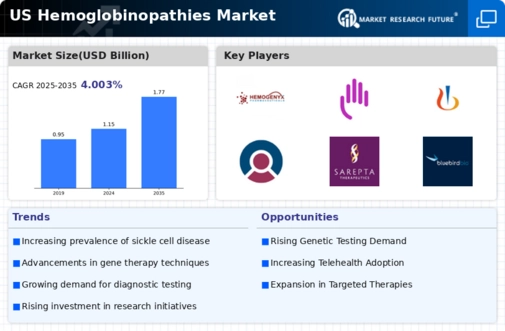Government Initiatives and Funding
Government initiatives aimed at addressing hemoglobinopathies are playing a pivotal role in shaping the hemoglobinopathies market. In the US, federal and state programs are increasingly focusing on research funding and public health campaigns to raise awareness about these disorders. For instance, the National Institutes of Health (NIH) allocates substantial resources for research on sickle cell disease and thalassemia, which fosters innovation in treatment options. Additionally, public health initiatives aimed at screening and education are likely to enhance early diagnosis and management of hemoglobinopathies. Such government support not only drives research and development but also encourages collaboration among stakeholders, thereby contributing to the overall growth of the hemoglobinopathies market.
Rising Demand for Targeted Therapies
The shift towards personalized medicine is significantly influencing the hemoglobinopathies market. There is a growing demand for targeted therapies that address the specific genetic and molecular underpinnings of hemoglobin disorders. Treatments such as gene therapy and novel pharmacological agents are gaining traction, as they offer the potential for more effective management of conditions like sickle cell disease. The US market is witnessing an increase in clinical trials and research focused on these innovative therapies, reflecting the healthcare community's commitment to improving patient outcomes. As the demand for targeted therapies continues to rise, the hemoglobinopathies market is expected to expand, attracting investments and fostering advancements in treatment options.
Advancements in Diagnostic Technologies
Recent innovations in diagnostic technologies are transforming the landscape of the hemoglobinopathies market. Techniques such as next-generation sequencing and high-performance liquid chromatography are enabling more accurate and rapid diagnosis of hemoglobin disorders. These advancements facilitate early detection, which is crucial for effective treatment and management of conditions like sickle cell disease and thalassemia. The US market is witnessing a surge in the adoption of these technologies, driven by the need for precise and timely diagnosis. As healthcare providers increasingly rely on advanced diagnostic tools, the hemoglobinopathies market is likely to experience growth, as these technologies not only improve patient outcomes but also enhance the overall efficiency of healthcare delivery.
Increased Focus on Patient-Centric Care
The emphasis on patient-centric care is reshaping the hemoglobinopathies market. Healthcare providers are increasingly recognizing the importance of tailoring treatment plans to meet the individual needs of patients with hemoglobin disorders. This approach not only enhances patient satisfaction but also improves adherence to treatment regimens. In the US, there is a growing trend towards integrating multidisciplinary care teams that include hematologists, genetic counselors, and social workers to provide comprehensive support for patients. Such initiatives are likely to lead to better health outcomes and quality of life for individuals affected by hemoglobinopathies. As patient-centric care becomes more prevalent, the hemoglobinopathies market is expected to evolve, with a focus on holistic management strategies.
Increasing Prevalence of Hemoglobinopathies
The rising incidence of hemoglobinopathies, particularly sickle cell disease and thalassemia, is a critical driver for the hemoglobinopathies market. In the US, it is estimated that approximately 100,000 individuals are affected by sickle cell disease, with a significant number of new cases diagnosed annually. This growing patient population necessitates enhanced healthcare services and treatment options, thereby propelling market growth. Furthermore, the increasing awareness of these disorders among healthcare professionals and the general public contributes to early diagnosis and intervention, which is essential for effective management. As the prevalence of hemoglobinopathies continues to rise, the demand for innovative therapies and supportive care solutions in the hemoglobinopathies market is expected to expand, creating opportunities for stakeholders in the healthcare sector.

















Leave a Comment